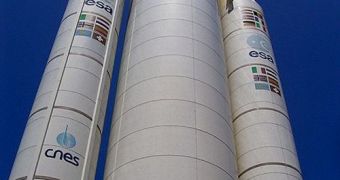Last night, at 22:27 CET (21:27 GMT), an Ariane 5 heavy-lift delivery system launched from the Kourou Spaceport in the French Guyana, carrying two new satellites for insertion in Earth's orbit.
The take-off took place at a facility operated by the European Space Agency (ESA), which decided to build the Kourou center in South America because the southern hemisphere offers better orbital insertion opportunities.
The V199 flight marked the sixth successful Ariane 5 launch this year, and also the last. Hispasat-1E and Koreasat-6, the two communication satellites that shared the ride, have been delivered safely to their intended destinations.
According to an ESA statement, the “target injection orbit had a perigee altitude of 250 km, an apogee altitude at injection of 35 786 km and an inclination of 3º.” The two satellites separated from the payload fairing 27 minutes and 34 minutes after liftoff, respectively.
“Hispasat-1E will be positioned in ‘geostationary orbit’ above the equator at 30ºW. It will provide direct-to-home television, digital terrestrial television and high-definition television services, as well as value-added broadband services to mobile, land and maritime users,” ESA officials add.
“Koreasat-6, to be positioned over 116ºE, carries 24 Ku-band channels to provide Fixed Satellite Services and six channels for Direct Broadcast Services,” the statement goes on to say.
The type of orbit the two spacecraft are in is called geostationary, because anything on it appear not to move, when seen from Earth. In fact, satellites in these circular orbits move at the same speed as Earth's rotation.
Yesterday's was not the first launch attempt for the V199 mission. Originally, it was scheduled to lift off on Tuesday, at 2126 GMT, but strong, high-altitude winds eventually forced officials to call the attempt off, Space reports.
“Ladies and gentlemen, I'm sorry to have to tell you but the latest wind measurements that we have made just before the launch are not good, which means we are unable to guarantee the safety of the launch operation,” announced Tuesday night Joel Barre.
He holds an appointment at the French space agency, and is also the head of the Guiana Spaceport.
“Obviously the spacecraft have been put into secure conditions, as has the launch vehicle. We'll take a look at the situation to confirm the launch for tomorrow, provided that the weather conditions allow for it,” added Jean-Yves Le Gall.
“Have a good evening and see you tomorrow, I hope,” concluded the expert, who is the chairman and CEO of Arianespace, the European consortium that manufactures Ariane 5 rockets.

 14 DAY TRIAL //
14 DAY TRIAL //